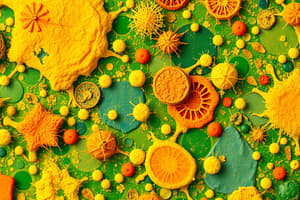Podcast
Questions and Answers
What happens to starch granules when they are heated in a moist environment?
What happens to starch granules when they are heated in a moist environment?
- They become brittle and break apart.
- They retain their original structure without changes.
- They completely dissolve in water.
- They undergo swelling as they absorb water. (correct)
Which of the following describes a key change in the structure of starch granules upon heating in a moist environment?
Which of the following describes a key change in the structure of starch granules upon heating in a moist environment?
- Granules become more compact and dense.
- Granules are converted into a gel-like substance.
- Granules absorb water and disrupt their organized structure. (correct)
- Granules develop a crystalline structure.
What is the primary effect of absorbing water on starch granules during heating?
What is the primary effect of absorbing water on starch granules during heating?
- Formation of a stable crystalline pattern.
- Increased viscosity and thickness of the granules.
- Complete phase separation from water.
- Swelling and a loss of organized structure. (correct)
What process primarily initiates the changes in starch granules during moist heating?
What process primarily initiates the changes in starch granules during moist heating?
When starch granules are heated in the presence of moisture, what structural change occurs?
When starch granules are heated in the presence of moisture, what structural change occurs?
Flashcards are hidden until you start studying
Study Notes
Heating Starch Granules
- Starch granules undergo significant changes when heated in a moist environment.
- Initial process involves the absorption of water, leading to granule swelling.
- Swelling is caused by water molecules penetrating the granule structure.
- As granules absorb water, their organized structure begins to disrupt.
- The organization of starch granules is essential for their functionality in food applications.
- Disruption affects the physical properties of starch, influencing texture and consistency in food products.
- Understanding these changes is crucial for applications in cooking and food production.
Studying That Suits You
Use AI to generate personalized quizzes and flashcards to suit your learning preferences.




